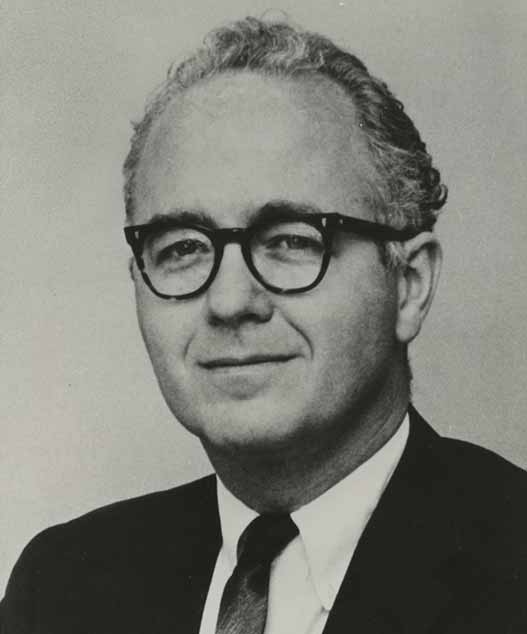Keith Brueckner, Founding Chair of Department of Physics, Dies at 90
Published Date
By:
- Susan Brown
Share This:
Article Content
Keith Brueckner, University of California, San Diego's founding physicist, died September 19. He was 90.

Photo courtesy of UC San Diego Library, Special Collections and Archives
Roger Revelle, founder of UC San Diego, hired Brueckner in 1959 to create a physics department for the fledgling campus from scratch.
In his remarks at the 25th reunion of this founding group of physicists, Brueckner recalled choosing faculty who could make fundamental contributions with few initial resources, because at the time, the main campus was just an idea. Among the luminaries he recruited were Walter Kohn and Maria Mayer who were each subsequently awarded Nobel Prizes for their work.
Brueckner's career encompassed research accomplishment, academic leadership and service to the nation.
Born March 19, 1924 in Minneapolis, Brueckner earned degrees in mathematics from the University of Minnesota and a Ph.D. in theoretical physics at UC Berkeley in 1950 working on elementary particle physics.
Brueckner spent a year at the Institute for Advanced Studies, another at Brookhaven National Laboratory, and served on the physics faculties of Indiana University and the University of Pennsylvania before moving to La Jolla. He served as a consultant to the U.S. government in several capacities, notably for U.S. Atomic Energy Commission from 1954 to 1970.
At UC San Diego, Brueckner launched the department of physics, hiring accomplished scientists in the fields of sold-state physics, plasma physics and astrophysics, and served as the first chair of the department. As Dean of Letters and Sciences, he hired key founding faculty in other disciplines as well, including psychology, linguistics and mathematics. He also served as the initial Dean of Science and Engineering and a brief spell as Dean of Graduate Studies.
“Keith Brueckner was one of a vanguard of leaders that first came to UC San Diego. He was, along with Roger Revelle, one of the group that went across the country recruiting the very best faculty,” said Mark Thiemens, Dean of the Division of Physical Sciences. “What was quite notable was that he recruited in all disciplines — science and non-science — and played a role in shaping the university’s breadth, which remains to this day.”
Brueckner was the inaugural director of UC San Diego's Institute for Radiation Physics and Aerodynamics, created to train scientists at the intersections of physics, chemistry, engineering and mathematics. He also directed the similarly interdisciplinary Institute for Pure and Applied Physics for two years.
“Keith Brueckner was a visionary who saw far ahead of his contemporaries. His imprint on the Physics Department and all of UC San Diego is both profound and lasting,” said Dimitri Basov, Chair of the Department of Physics.
Brueckner came of age as a physicist just as the mysteries of the atomic nucleus came into focus. One of his first contributions was to show that emerging data provided evidence for internal, excited states of the proton, previously thought to be a fundamental building block of matter. But his deepest contribution concerned the “many-body problem.” Examples are all around us, in the way in which atoms and molecules come together to form liquids and solids, and similar problems arise in thinking about the many electrons in an atom, or the many protons and neutrons in the nucleus.
Every particle can interact with all the others, and early approaches to calculating the consequences of these interactions led to complete nonsense. In 1955, Brueckner showed how to reorganize these calculations so that the nonsensical terms vanished, making it possible to recover meaningful results. Within this framework, he and his collaborators went on to show how very strong interactions among many particles could give rise to surprisingly simple behaviors, in which each particle seemed to be moving almost freely. These ideas have had a lasting impact on our understanding of how the behavior of matter as we see it emerges from the underlying, subatomic rules.
In recognition of these and other contributions, Brueckner was awarded the Dannie Heineman Prize in Mathematical Physics by the American Physical Society in 1963, was elected to the American Academy of Arts and Sciences in 1968, and to the National Academy of Sciences in 1969.
In the 1970s, Brueckner turned to the problem of extracting energy from nuclear fusion, trying to understand how lasers could heat matter to the astronomical temperatures required for fusion to occur. His work, both at the university and at KMS Fusion, which he helped found, was near the originsof the now international effort to achieve practical laser fusion.
Apart from his work as a scientist, Brueckner was an avid rock climber. Many in the San Diego climbing community particularly remember shared moments on the boulders of Mount Woodson in Poway for which he wrote a guidebook in 1987 that is still in use.
On the occasion of Brueckner's retirement in 1991, Roger Revelle said, “UCSD would be a far different place if Keith Brueckner had not thrown his enormous energy, his creative mind, and his strong character into the building of this new university.”
He is survived by his wife, Bonnie Brueckner, and his children Leslie Brueckner and Jan Brueckner, and step-children Charlotte Bialek, Barbara Caselli, Carolyn Miller and Patrick Klavas.
Share This:
Stay in the Know
Keep up with all the latest from UC San Diego. Subscribe to the newsletter today.



